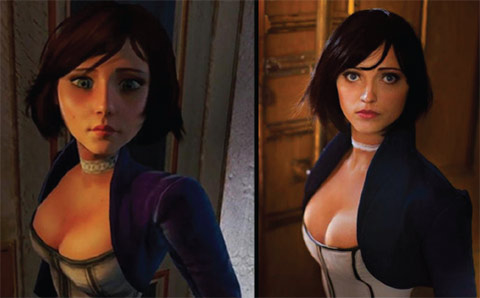Suiting up: Cosplay
 Ann Moleva of Moscow (right) was hired by Irrational Games as the official face of their 2013 release Bioshock: Infinite after cosplaying as protagonist Elizabeth the summer before the game�s release.
Ann Moleva of Moscow (right) was hired by Irrational Games as the official face of their 2013 release Bioshock: Infinite after cosplaying as protagonist Elizabeth the summer before the game�s release.Cosplay, or kosupure, as it is known as in Japan, is far more than what it appears to be on the surface: a group of adults dressed as an assortment of video game or anime characters and descending upon a convention full of like-minded geeks. Beneath what is immediately visible, however, is a very serious and passionate group of people, devoted to what has become less of a dress-up game, and more of a performance art.
When a group of cosplayers is witnessed by someone outside of their community, it can be easy to write them off as simply people in costume heading to some convention, but a true cosplayer is far more than what they are wearing. It is a worldwide, cultural phenomenon that is growing more popular each year, devoted to not just looking like a particular character, but actually becoming that character in terms of movements, voice and mannerisms. The most serious of cosplayers will spend an entire event speaking, walking and posing for photos, all without breaking the illusion that they are a fictional character come to life.
Outside of the obvious appeal that cosplay has in the eyes of comic book and anime fans, it has also become a popular platform for amateur clothiers to show off their talents, whether they are creating a costume for themselves or they have been hired to create something else. In the last decade, online suppliers such as cosplayhouse.com and hellocosplay.com have begun offering individually tailored costumes with hundreds of options taken from a wide variety of sources. With the growing popularity of the practice, more people are getting involved and are willing to pay premium prices to websites such as these. Some of the more complicated costumes on these sites consist of dozens of individual pieces that must be made to fit their wearer, allowing cosplayers to go to their convention in an outfit that is made well, fits properly and, most importantly in the cosplay world, as accurate as possible to the source material.
With such a large number of participants descending onto major fan conventions such as Toronto's annual Anime North and San Diego's Comic Con (the largest in Canada and the U.S. respectively) the culture surrounding cosplay has become synonymous with bringing together groups of people who share common interests, especially when that interest is something that lies far away from the mainstream. Many people who have a vested interest in these genres are seen as part of the “hardcore nerd” population that lacks the usual social skills to interact with the general public.
“Cosplaying faces a stigma because it is seen as being very nerdy. For example, many people imagine a 21-year-old, overweight young man who stays up all night long playing video games and does not have the social skills to converse with people in real life cosplaying,” said Kristen Curtis, a Toronto-based cosplayer who has become more active in the community in recent years. She, like many others, grew up watching the early waves of anime that began the Western world's ongoing fascination in the Japanese cartoon style, which planted the seeds that would eventually grow into her interest in the cosplay culture. “Growing up I was really into shows such as Sailor Moon and Pok�mon, and cosplay allows me to feel almost nostalgic, to be able to dress up and revisit the television shows that I once loved.”
This nostalgic sentiment is one that anyone who has grown out of what they loved as a child can relate to, as is the desire to somehow revisit those memories later on in life without the worry of being ostracized, something that, despite what any detractors may say, the cosplay community has been able to demonstrate year in and year out. “The cosplay community is one of the most welcoming and encouraging communities that I have been a part of, especially when welcoming newcomers,” said Curtis, herself generally quiet and reserved around those she does not know. “I know many members of the community were bullied in school as children or teens and still do not necessarily feel like they fit in anywhere.” The sense of community that cosplayers have found amongst themselves has been manifested in a series of online communities devoted to keeping cosplay alive in between major conventions. A quick view of a Canadian cosplaying message board shows a list of several planned events, many of which have 50-plus people subscribed, further proving that the people of this community share a continuing respect for each other, as well as in interest in keeping their group intact.
For anyone who has any desire to experiment with cosplaying, Curtis recommended travelling to a major convention in Toronto in order to get the full experience. “You can get costumes online or secondhand, many at a reasonable price, create them from a pattern or just throw together bits of an old Halloween costume. Like I said before, the community is extremely welcoming to newcomers.”
When selecting a character to become, choose one that you have some sort of emotional connection to, or one that is very dear to your heart. “I like to cosplay as cheeky, cute characters (such as Pikachu, a Pok�mon) or strong, sexy and independent female characters (such as Samus of the Metroid series). Each character that I cosplay as portrays some aspect of my personality.”
Further reading on the Toronto community, as well as a list of scheduled events, can be found on the Canada Cosplay forum of cosplay.com.













